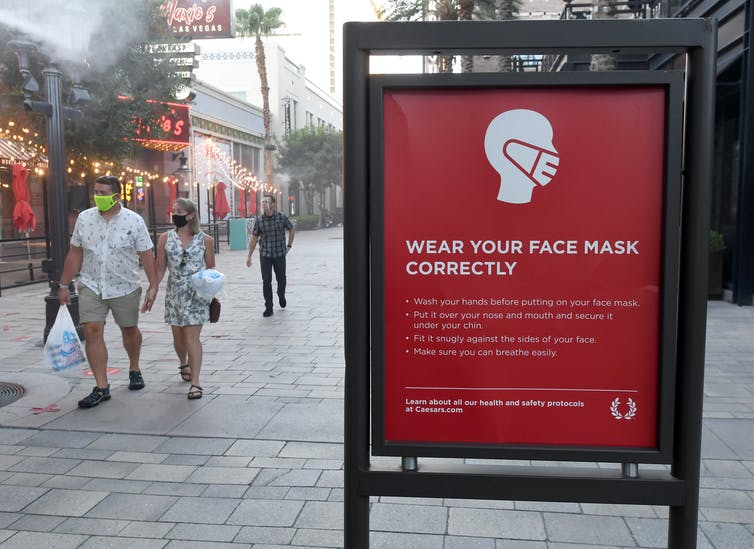Although many people are eager to remove their masks, experts and much of the public increasingly recognize that indoor mask mandates can provide protection in areas where COVID-19 cases, hospitalizations and deaths are high. Now, Nevada is leading the way in implementing state-level indoor mask policies that adjust to local COVID-19 case data, an approach that is well suited to a longer-term and evolving pandemic.
As of early August, the U.S. has the largest daily increase in COVID-19 cases in the world. Because of growing hospitalization and death rates and the increasing threat of the highly transmissible delta variant, in late July the CDC issued a new recommendation, calling for all people to wear masks in public settings indoors, regardless of vaccination status, in “areas of substantial or high transmission.” The announcement followed presentation of an internal document obtained by The Washington Post in which CDC scientists highlighted their main recommendation in a bold, red box: “Universal masking is essential to preventing the spread of the delta variant.”
State policies are likely to shape how well the CDC’s recommendations help protect public health. In late July, Nevada adopted a new mask mandate that has an on and off switch based on local transmission rates. Louisiana’s new statewide mask mandate took effect Aug. 4, 2021. And Arkansas is now rethinking its indoor mask ban.
We are a team of policy researchers based at Boston University School of Public Health, and since the start of the pandemic we have tracked more than 200 policies in the COVID-19 U.S. State Policy (CUSP) database. Analyses relying on the data we collected indicate that state mask policies could play a critical role in reducing COVID-19 transmission, especially as it becomes clear that vaccines may not be enough to combat the delta variant. As we closely followed evidence on state policies, we observed that state indoor mask policies were the most effective and least burdensome way to curb the spread of COVID-19 and reduce health inequities, alongside vaccines.
State masking policies can be individually tailored
Based on our review, we think Nevada’s mask policy can help address a longer-term, constantly evolving COVID-19 pandemic. Although mask-wearing can reduce the risk of transmission in all indoor public spaces, this rule ensures that people can be protected by masks in areas where COVID-19 transmission rates are substantial or high, while allowing for flexibility to keep masks off in areas where transmission is lower.
The mandate has no expiration date and can remain in place perpetually throughout changing pandemic circumstances, from upticks in cases to emergence of new variants. It is based on CDC definitions of high and substantial transmission that can be adjusted in response to changing hospitalization and death rates.
Nevada’s policy approach of linking mask mandates to COVID-19 transmission rates is also well suited to states like Mississippi and Wyoming, where cases exceed the CDC definition of high or substantial transmission in all counties. It could also work well for states like Massachusetts and Wisconsin; most counties there had moderate transmission at the time of the CDC’s announcement, but cases have rapidly increased and most counties now meet the threshold of high or substantial transmission.
Ethan Miller/Getty Images News via Getty Images
In Louisiana, the statewide mask mandate is set to expire on Sept. 1, 2021. If replaced by a policy linked to data like that in Nevada, it could allow local mandates to remain in place in some counties. Even in Vermont, where Gov. Phil Scott has led the state in achieving the highest vaccination rate in the country, a policy like Nevada’s is well suited to a context in which cases are increasing and some areas may face substantial or high transmission in time.
Mask mandates complement vaccines
As we tracked COVID prevention policies, we found that mask policies reduced transmission with fewer consequences than many other policies. A June 2020 study using the CUSP data showed that state mask orders were associated with reduced COVID-19 growth rates. Importantly, mask orders do not result in the same educational or economic losses as other policy approaches to reducing COVID-19, such as school closures and business closures. In combination with other public-health strategies like vaccine delivery and improved ventilation, these mandates may allow us to continue to gather in person safely.
Although nearly 50% of the U.S. population has been fully vaccinated as of early August, mounting evidence shows that breakthrough infections can occur in fully vaccinated people. Though vaccines reduce disease severity, serious cases can still occur in vaccinated individuals. And vaccinated people who become infected can transmit COVID-19 to others.
Whether vaccinated or unvaccinated people wear a mask affects not just their own COVID-19 risk, but the risk to others. On average, each person with COVID-19 infects about seven other people, given the increased transmissibility of the delta variant. In areas where COVID-19 transmission is high, universal indoor masking can help protect adults who are vulnerable to severe COVID-19 because of immunosuppression or age and children under 12 who are not yet eligible to be vaccinated.
Using policy to promote equity
While the work to vaccinate more people is ongoing, mask policies that lower the overall toll of COVID-19 may also reduce racial and ethnic disparities in COVID-19. As a result of a long history of structural racism, the COVID-19 pandemic has disproportionately affected people who are Black, Latino and Native American. Younger people in those groups, in particular, have suffered more COVID-19 deaths than their white counterparts.
[Over 100,000 readers rely on The Conversation’s newsletter to understand the world. Sign up today.]
Our analysis using data from the U.S. Census Bureau’s Household Pulse Survey shows that people who have low incomes and who face food insecurity, and those who have kids, are less likely to be vaccinated. Yet many of these people report that they still plan to be vaccinated, highlighting that they face structural barriers to getting vaccinated. For instance, workers in low-wage, public-facing jobs, who are disproportionately Black and Latino, often lack access to paid leave to receive vaccines or recover from side effects. Mask policies can help to protect these workers who face an elevated risk of exposure to COVID-19 at work.
Indoor mask policies are highly effective for preventing COVID-19 transmission, and they work best when everyone wears masks. Masks complement and amplify protection from vaccines when vaccines alone have not been sufficient to avert increasing hospitalizations and deaths, especially among children. As COVID-19 threatens people’s health and the economy, flexible mask policies like Nevada’s are a way for the U.S. to take coordinated action. Ultimately, those efforts could help people continue gathering safely and sharing indoor spaces in businesses and schools so they can remain open, and taking masks off when it is safer to do so.



